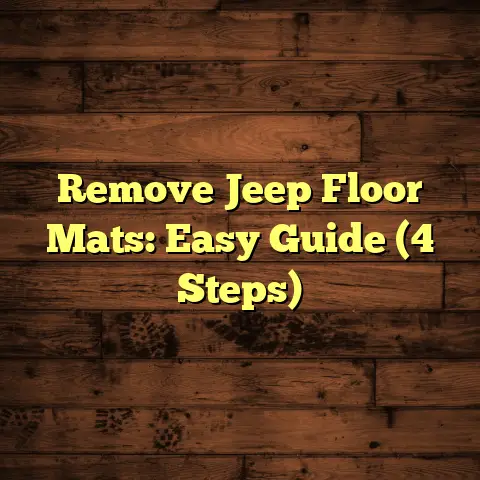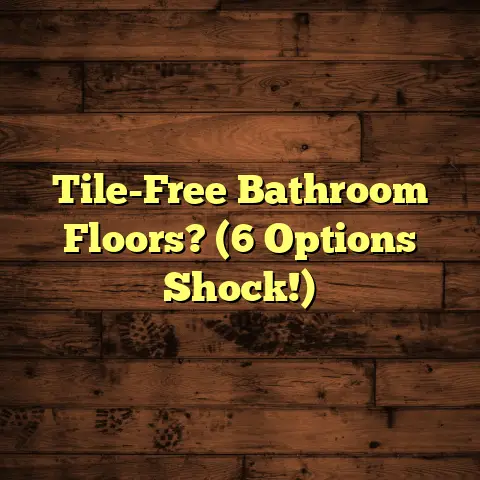Hardwood Hardness Chart (Top 5 Scratches!)
Top 5 Scratches and How to Fight Back!
And let me tell you, in my years of experience, I’ve seen it all when it comes to hardwood floors.
From the gorgeous, gleaming planks that stop you in your tracks, to the… less-than- perfect floors bearing the battle scars of everyday life.
Today, we’re diving deep into the world of hardwood, focusing on two critical aspects: hardness and scratches.
But before we get down to the nitty-gritty, let’s talk about something near and dear to my heart: sustainability.
In today’s world, it’s more important than ever to make eco-conscious choices, especially when it comes to home improvement.
And that’s where hardwood flooring really shines!
The Beauty of Sustainable Hardwood
Unlike synthetic alternatives, hardwood is a natural, renewable resource.
When sourced from responsibly managed forests, it’s a sustainable choice that can actually help reduce our carbon footprint.
Think about it: trees absorb carbon dioxide from the atmosphere as they grow.
And when that wood is harvested and turned into flooring, that carbon remains stored within the wood for decades to come.
Plus, sustainable forestry practices ensure that forests are replanted and managed for long-term health, protecting biodiversity and preventing deforestation.
As a flooring contractor, I always advise my clients to look for certifications like the Forest Stewardship Council (FSC) when choosing hardwood.
This guarantees that the wood comes from well-managed forests that meet strict environmental and social standards.
Now, why am I preaching about sustainability?
Because it’s not just about doing what’s right for the planet; it’s also about making smart long-term investments for your home.
A sustainably sourced hardwood floor is not only beautiful and durable, but it also adds value to your home and contributes to a healthier environment.
Okay, enough about my soapbox!
Let’s get down to the real reason you’re here: understanding hardwood hardness and how to protect your floors from those dreaded scratches.
Section 1: Understanding Hardwood Hardness
So, what exactly is hardwood?
Well, simply put, it’s wood that comes from deciduous trees – trees that lose their leaves annually.
Think oak, maple, cherry, walnut… the list goes on!
These woods are generally denser and more durable than softwoods, which come from coniferous trees like pine and fir.
But not all hardwoods are created equal.
Some are incredibly tough and resistant to dents and scratches, while others are a bit more delicate.
And that’s where the Janka hardness test comes in.
The Janka Hardness Test:
Decoding the Numbers
The Janka hardness test is the industry standard for measuring the resistance of wood to denting and wear.
It involves measuring the force required to embed a steel ball (0.444 inches in diameter) halfway into a piece of wood.
The higher the number, the harder the wood.
Why is this important for homeowners?
Well, if you have a busy household with kids, pets, or lots of foot traffic, you’ll want to choose a hardwood with a high Janka rating.
This will ensure that your floors can withstand the daily wear and tear without showing signs of damage too quickly.
On the other hand, if you’re looking for a more affordable option or prefer the look of a softer wood, you can still make it work by taking extra precautions to protect your floors.
And speaking of sustainability, it’s worth noting that some of the hardest woods are also sourced from responsibly managed forests.
So you don’t have to sacrifice your values to get a durable floor.
Section 2: The Hardwood Hardness Chart
Alright, let’s get to the good stuff!
Here’s a handy hardwood hardness chart that includes the Janka ratings for various species:
| Wood Species | Janka Rating |
|---|---|
| Brazilian Walnut | 3680 |
| Hickory | 1820 |
| Hard Maple | 1450 |
| Red Oak | 1290 |
| White Oak | 1360 |
| American Cherry | 950 |
| Black Walnut | 1010 |
| Yellow Pine | 690 |
| Douglas Fir | 660 |
Note: Janka Hardness ratings can vary slightly depending on the source and specific growing conditions.
Now, let’s take a closer look at the top five hardest woods on this list:
1. Brazilian Walnut (Ipe) – Janka: 3680
This exotic hardwood is a true powerhouse when it comes to durability.
It’s incredibly dense and resistant to scratches, dents, and even insects!
Brazilian Walnut boasts a rich, chocolate- brown color with subtle variations that add character to any space.
It’s commonly used for high-end flooring, decking, and furniture.
From a sustainability standpoint, it’s crucial to ensure that your Brazilian Walnut is sourced from responsibly managed forests with proper certification.
2. Hickory – Janka: 1820
Hickory is a domestic hardwood that’s known for its strength and shock resistance.
It has a distinctive grain pattern and a range of colors from creamy white to reddish-brown.
Hickory is a popular choice for flooring, cabinets, and tool handles.
It’s a relatively sustainable option, as it’s widely available in North America and can be harvested using sustainable forestry practices.
3. Hard Maple – Janka: 1450
Hard Maple, also known as Sugar Maple, is a classic hardwood that’s prized for its smooth, uniform grain and light color.
It’s a versatile wood that can be stained to match any décor.
Hard Maple is commonly used for flooring, furniture, and even bowling alleys!
It’s a sustainable choice, as it’s abundant in North America and can be harvested using sustainable forestry practices.
4. White Oak – Janka: 1360
White Oak is a timeless hardwood that’s known for its durability, water resistance, and beautiful grain pattern.
It has a warm, golden-brown color that adds a touch of elegance to any room.
White Oak is a popular choice for flooring, furniture, and even boat building.
It’s a sustainable option, as it’s widely available in North America and can be harvested using sustainable forestry practices.
5. Red Oak – Janka: 1290
Red Oak is another popular hardwood that’s similar to White Oak but has a slightly redder hue and a more pronounced grain pattern.
It’s a durable and affordable option that’s suitable for a variety of applications.
Red Oak is commonly used for flooring, furniture, and trim.
It’s a sustainable choice, as it’s abundant in North America and can be harvested using sustainable forestry practices.
So, what does this chart mean for you as a consumer?
Well, it gives you a clear understanding of the relative hardness of different hardwood species.
This allows you to make an informed decision based on your lifestyle, budget, and aesthetic preferences.
Section 3: The Top 5 Scratches on Hardwood Floors
Okay, now let’s talk about the elephant in the room: scratches.
No matter how hard your hardwood floors are, they’re still susceptible to scratches.
It’s just a fact of life.
But understanding the different types of scratches and how they occur can help you prevent them and minimize their impact.
Here are the top five types of scratches I see most often as a flooring contractor:
1. Surface Scratches
These are the most common type of scratch.
They’re typically shallow and only affect the finish of the wood, not the wood itself.
Surface scratches are usually caused by everyday activities like:
- Dragging furniture
- Walking with shoes on
- Dropping small objects
- Pet nails
They appear as light, hazy lines on the surface of the floor.
2. Gouges
Gouges are deeper and more noticeable than surface scratches.
They penetrate the finish and actually remove some of the wood.
Gouges are often caused by:
- Dropping heavy objects
- Dragging sharp objects
- Accidental impacts
They appear as small dents or chips in the surface of the floor.
3. Deep Scratches
Deep scratches are the most severe type of scratch.
They penetrate deep into the wood and can compromise the structural integrity of the floor.
Deep scratches are usually caused by:
- Major impacts
- Severe abrasion
- Water damage
They appear as wide, deep lines or cracks in the surface of the floor.
4. Scratches from Pets
Ah, our furry friends.
We love them to bits, but their claws can wreak havoc on hardwood floors.
Pet scratches are often characterized by:
- Multiple, parallel lines
- Concentrated areas of damage (near doorways or favorite spots)
- Potential for deep scratches if nails are not trimmed
According to the American Pet Products Association (APPA), about 70% of U.S. households own a pet.
That’s a lot of potential for scratched hardwood floors!
5. Scratches from Furniture
Moving furniture is a common culprit when it comes to scratches.
Even seemingly harmless actions like sliding a chair or pushing a table can cause damage.
Furniture scratches are often:
- Long and linear
- Located in high-traffic areas
- Caused by the legs or base of the furniture
Using felt pads under furniture legs is a simple but effective way to prevent these types of scratches.
Section 4: Maintaining and Protecting Hardwood Floors
Now that you know the enemy, let’s talk about how to defend your floors!
Proper maintenance and protection are key to minimizing scratches and prolonging the life of your hardwood floors.
Here are some tips I always share with my clients:
- Regular Cleaning: Sweep or vacuum your floors regularly to remove dirt and debris that can scratch the surface.
- Appropriate Cleaning Products: Use cleaning products specifically designed for hardwood floors. Avoid harsh chemicals or abrasive cleaners that can damage the finish.
- Humidity Control: Maintain a consistent humidity level in your home to prevent the wood from expanding or contracting, which can lead to cracks and scratches.
- Mats and Area Rugs: Place mats at entrances to trap dirt and moisture. Use area rugs in high-traffic areas to protect the floor from wear and tear.
- Furniture Pads: Attach felt pads to the legs of all furniture to prevent scratches when moving them.
Section 5: Repairing Scratches and Damage
Even with the best precautions, scratches can still happen.
But don’t despair!
Most scratches can be repaired, either by yourself or by a professional.
Here’s a quick guide to repairing the different types of scratches:
- Surface Scratches: These can often be buffed out with a scratch repair kit or a specialized hardwood floor cleaner.
- Gouges: Fill the gouge with wood filler that matches the color of your floor. Sand smooth and apply a matching finish.
- Deep Scratches: These may require more extensive repairs, such as replacing the damaged boards or refinishing the entire floor.
There are many products available on the market for scratch repair, including:
- Wood Fillers: These are used to fill in gouges and deep scratches.
- Touch-Up Pens: These are used to cover up surface scratches and small imperfections.
- Refinishing Kits: These are used to remove the old finish and apply a new one.
When to Seek Professional Help:
If you’re not comfortable repairing the scratches yourself, or if the damage is extensive, it’s best to call in a professional.
A skilled flooring contractor can assess the damage and recommend the best course of action.
I once had a client whose dog had completely destroyed their hardwood floors.
The scratches were so deep and widespread that I recommended refinishing the entire floor.
After a few days of hard work, the floors looked brand new!
The client was thrilled with the results, and their dog (who was very apologetic, I’m sure) was none the wiser.
Conclusion
Well, there you have it!
A comprehensive guide to hardwood hardness, scratches, and how to keep your floors looking their best.
Remember, understanding the Janka hardness scale and choosing a wood that’s appropriate for your lifestyle is crucial for long-term satisfaction.
And don’t forget about sustainability!
By choosing responsibly sourced hardwood, you’re not only investing in a beautiful and durable floor, but you’re also doing your part to protect the environment.
So, what are you waiting for?
Take a look at your floors, assess the damage, and start planning your attack!
With a little knowledge and effort, you can keep your hardwood floors looking gorgeous for years to come.





